Contents
Ropes Creek railway line | |||||||||||||||||||||||||||||||||||
|---|---|---|---|---|---|---|---|---|---|---|---|---|---|---|---|---|---|---|---|---|---|---|---|---|---|---|---|---|---|---|---|---|---|---|---|
| |||||||||||||||||||||||||||||||||||

The Ropes Creek Line is a closed railway line in the western suburbs of Sydney, Australia.
Ropes Creek railway line | |||||||||||||||||||||||||||||||||||
|---|---|---|---|---|---|---|---|---|---|---|---|---|---|---|---|---|---|---|---|---|---|---|---|---|---|---|---|---|---|---|---|---|---|---|---|
| |||||||||||||||||||||||||||||||||||

The Ropes Creek Line is a closed railway line in the western suburbs of Sydney, Australia.
The Ropes Creek line was named after a nearby creek bearing the same name. It was built during World War II to transport munitions factory workers to and from St Marys. The line opened from St Marys to Dunheved on 1 March 1942 and Dunheved to Ropes Creek on 29 June 1942. When electrification arrived in the 1950s, there was a plan to electrify the Ropes Creek line. For the most part all the sidings in the Dunheved station area were electrified to enable the New South Wales Government Railways (NSWGR) to use electric locomotives of the 46 class to shunt trains without the need to change to diesel-electric or diesel-hydraulic locomotives.
While the line was being electrified, a new station named Cochrane was opened on 2 September 1957. Towards the end of train operation on the line, freight wagons were shunted into the Sims Metal plant which was about two kilometres from the junction with the Main Western line, and there was normally one passenger train in the morning and one in the afternoon, generally formed by a four-car single-deck suburban train, locally known as a red rattler.
The line was closed to passenger rail traffic in the early 1980s, following a downturn in passengers and munitions traffic, but remained open to freight traffic for Sims Metal. However, when that was switched to road traffic the line closed and lay idle for a number of years. On 22 March 1986, the line was officially closed forever, with an enthusiasts' special being the last train to traverse the section. Not long after that, the overhead power supply was removed.
Between Boxing Day 1990 and 8 January 1991 there was a major shut-down due to track work between St Marys and Glenbrook stations, and the line was temporarily reopened as far as Dunheved to allow suburban trains that normally stabled at Penrith to be stabled in the four-track yard, and on the platform 2 or "down" track on the branch. At the completion of the track work, the line was once again closed.
Overhead wiring for approximately 10 car lengths was retained at the St Marys end of the branch, where it turned off the main western line, to provide a terminating point for trains used on "Y" Link services. With the abolition of "Y" link services to St Marys in 2005, the overhead wiring and associated components were subsequently removed.
At Dunheved railway station, a fenced-in compound was constructed on the down branch and down no. 1 siding, and two suburban carriages - Comeng S set motor car C3866 and Tangara car N5127 - were stored there for use by the NSW Fire Brigade for training purposes. The carriages and the compound didn't last long because local vandals destroyed both vehicles.
Rails on the branch were still in place in 1996 but by 2001 track lifting had commenced. The first part of the line to be removed was the area outside Sims Metal, to allow the extension of Christie St between Dunheved Rd and across South Creek. The next section of track, the Links Rd level crossing, was covered with tar and concrete.
1 December 1957
Down:
Up:
The formerly electrified line, which boasted three stations (Dunheved, Cochrane and Ropes Creek), has been truncated at the Sims Metal recycling facility on Christie Street, Dunheved, and all track and overhead wiring beyond that point has been removed.
Other than the island platform, the only remnants of Dunheved station are the footbridge, including the steps leading to the island platform, with the remains of an electrical hut located under the stairs. A large hole in the platform with a few metal pulleys is the only remaining evidence that a signal box was located within the station building.
In April 2011, the stairs were removed and the railings on the footbridge made good. The stairs had been the standard pattern pre-cast concrete on steel framework, and had weathered to the point where the concrete was crumbling. The old platform retains its former appearance and there is a park on its northern side. At one stage, the rail formation and yard area at the western end of Dunheved station were used by a local company for the storage of concrete pipes.
A satellite view of the line north of Links Rd (Dunheved) on NSWRail Maps 22 April 2008 showed that urban sprawl had meant that the site of Cochrane Railway Station had disappeared under Ropes Crossing Boulevard. Ropes Creek railway station was under threat of extinction due to earthworks associated with the construction of local roads, and the expansion of the new suburb of Ropes Crossing was well under way.
At 8 June 2009, Ropes Creek station platform has been heavily excavated and shortened to approximately 50 m, with only the area containing the overhead footbridge and platform buildings remaining and fenced off from public access. This has been designated a heritage area. Within this fenced off area, signals (both semaphore and colour light) along with other various pieces of track-side equipment was dumped in piles with no regard to their heritage importance. A large sign on the fence indicated that the station would be part of a proposed "Cultural Park".
During 2014, the remnants of the station were converted to a local park for Ropes Crossing residents, with the remaining platform, overhead beams, rail tracks and old machinery featured as design elements. The park also displays two reproduction station signs on the platform reading "Ropes Creek Station".
Owing to the Campbelltown to St Marys (Cumberland Line) trains now operating along Richmond railway line towards Richmond or Schofields, and the abolition of The River (the St Marys to Wyong service), there is now no requirement for the electrification of the storage sidings on the former Ropes Creek Line. Overhead wiring between the points on the Up Main to the Up Storage Sidings and the electric train stop boards has been removed. The sidings are now used for the storage of track machines during rail shut-downs or whenever scrapped rolling stock is delivered to the Sims Metal recycling plant.
Early stage planning for Outer Sydney Orbital, a transport corridor travelling from Marsden Park, New South Wales in the north, to Menangle, New South Wales in the south, clearly shows a rail line turning to pass through the vicinity of the Dunheved railway station, possibly due to future shipping requirements of the area to relieve current road transport. The line then returns to the main corridor, and does not continue to Ropes Crossing.
The station buildings along the line were built from different materials.


There is now a notice at the southern end of the site indicating that an historical centre may be erected.

Central is a heritage-listed railway station located in the centre of Sydney, New South Wales, Australia. The station is the largest and busiest railway station in Australia and serves as a major transport interchange for NSW TrainLink inter-city rail services, Sydney Trains commuter rail services, Sydney light rail services, bus services, and private coach transport services. The station is also known as Sydney Terminal. The property was added to the New South Wales State Heritage Register on 2 April 1999. It recorded 85.4 million passenger movements in 2018 and serves over 250,000 people daily.

Redfern railway station is a heritage-listed former railway bridge and now railway station located on the Main Suburban railway line in the Inner City Sydney suburb of Redfern in the City of Sydney local government area of New South Wales, Australia. It was designed by John Whitton and built by Department of Railways. It is also known as Redfern Railway Station group and Tenterfield railway. The property was added to the New South Wales State Heritage Register on 2 April 1999.

Waverton railway station is a heritage-listed railway station located on the North Shore line, serving the Sydney suburb of Waverton in New South Wales, Australia. It is served by Sydney Trains T1 North Shore line services. The station is located on Bay Road, Waverton, in the North Sydney Council local government area of New South Wales, Australia. It was designed and built by New South Wales Department of Railways. It is also known as Waverton Railway Station group. The station was added to the New South Wales State Heritage Register on 2 April 1999.
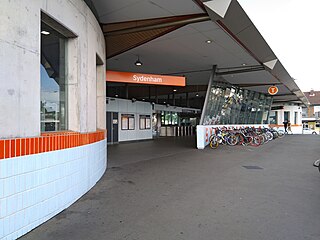
Sydenham railway station is a heritage-listed railway station located on the Illawarra line, serving the Sydney suburb of Sydenham in New South Wales, Australia. It is served by Sydney Trains T3 Bankstown, T4 Illawarra and T8 South services. It was designed by the New South Wales Government Railways and built from 1884 to 1962, with William Robinson having built the original 1884 buildings. It was added to the New South Wales State Heritage Register on 2 April 1999.

Tempe railway station is a heritage-listed railway station located on the Illawarra line, serving the Sydney suburb of Tempe in New South Wales, Australia. It is served by Sydney Trains T4 line services. It was originally built in 1884. The 1884 buildings were designed by the New South Wales Government Railways and built by C. Mayes; the 1918 footbridge was manufactured by Dorman Long. It was added to the New South Wales State Heritage Register on 2 April 1999.

Strathfield railway station is a heritage-listed railway station located on the Main Suburban line in the Sydney suburb of Strathfield in the Municipality of Strathfield local government area of New South Wales, Australia. The station is served by Sydney Trains T1 North Shore & Western Line, T9 Northern Line and T2 Inner West & Leppington Line suburban services as well as NSW TrainLink Intercity and regional services. The station is located on the Main Northern and Main Western railway lines, forming a major junction for regional and suburban rail services. The station and associated infrastructure was added to the New South Wales State Heritage Register on 2 April 1999.
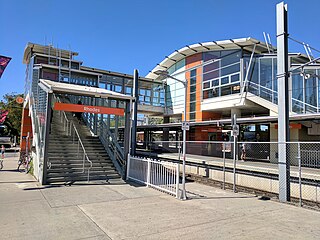
Rhodes railway station is a heritage-listed railway station located on the Main Northern line, serving the Sydney suburbs of Rhodes and Liberty Grove both in City of Canada Bay, Sydney, New South Wales, Australia. It is served by Sydney Trains T9 Northern Line services.
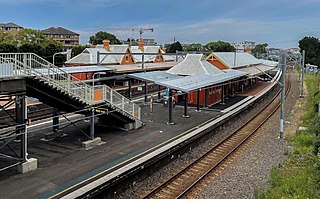
Arncliffe railway station is a heritage-listed railway station located on the Illawarra line, serving the Sydney suburb of Arncliffe in Bayside Council. It is served by Sydney Trains T4 line services. It was added to the New South Wales State Heritage Register on 2 April 1999.

Rockdale railway station is a heritage-listed railway station located on the Illawarra line, serving the Sydney suburb of Rockdale in Bayside Council. It is served by Sydney Trains T4 line services. It was added to the New South Wales State Heritage Register on 2 April 1999.

Canterbury railway station is a heritage-listed railway station located on the Bankstown line at Canterbury in the City of Canterbury-Bankstown local government area of New South Wales, Australia. The station is served by Sydney Trains T3 Bankstown line services. The station was designed by New South Wales Government Railways and built from 1895 to 1915 by J. J. Scouller. It is also known as Canterbury Railway Station group. The property was added to the New South Wales State Heritage Register on 2 April 1999.

Flemington railway station is located on the Main Suburban line, serving the Sydney suburb of Flemington. It is served by Sydney Trains T2 Inner West & Leppington line services. Due to the naming dispute of the suburb and the importance of the neighbouring Sydney Markets, the station has been proposed to be renamed as Sydney Markets railway station.

Gerringong railway station is a single-platform intercity train station located in Gerringong, New South Wales, Australia, on the South Coast railway line. The station serves NSW TrainLink diesel multiple unit trains travelling south to Bomaderry and north to Kiama. Early morning and late night services to the station are provided by train replacement bus services. In the past, the station precinct also catered to freight trains carrying dairy products.

St Marys railway station is a heritage-listed former goods yard, railway signal box and now railway station located on the Main Western line in the western Sydney suburb of St Marys in the City of Penrith local government area of New South Wales, Australia. The station is served by Sydney Trains T1 Western line services. The station marks the end of the four-track section of the Main Western line. It was designed by New South Wales Government Railways and was built in 1862. It is also known as St. Marys Railway Station Group and St Marys Railway Station. The property was added to the New South Wales State Heritage Register on 2 April 1999.

Sydney, the largest city in Australia, has an extensive network of passenger and freight railways. The passenger system includes an extensive suburban railway network, operated by Sydney Trains, a metro network and a light rail network. A dedicated freight network also exists. Future expansion of the light rail network includes the Parramatta Light Rail. Existing light rail services are the Inner West Light Rail and the CBD & South East Light Rail.

The Main Suburban railway line is the technical name for the trunk railway line between Redfern railway station and Parramatta railway station in Sydney, Australia, but now generally refers to the section between Redfern and where the Old Main South Line branches off at Granville Junction. The railway line then continues on as the Main Western line towards the Blue Mountains. This term distinguished this trunk line from the Illawarra Line which branched south from the Illawarra Junction to Wollongong, and later the North Shore tracks which carried trains north over the Harbour Bridge.
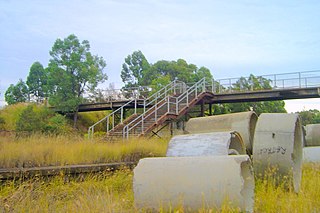
Dunheved railway station was the first station and a junction on the Ropes Creek railway line in Sydney, New South Wales, Australia. It was the only station on the Ropes Creek line named after a suburb (Dunheved).
Cochrane Station was the second of three stations on the Ropes Creek railway line in Sydney, New South Wales, Australia.

Ropes Crossing is a suburb of Blacktown, Sydney in the state of New South Wales, Australia. Ropes Crossing is located 49 kilometres (30 mi) west of the Sydney central business district, in the local government area of the City of Blacktown and is part of the Greater Western Sydney region.
Lilyvale railway station is a former railway station on the Illawarra railway line in New South Wales, Australia.
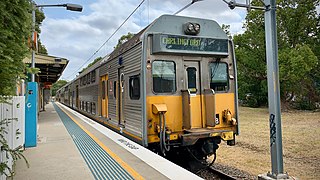
The Carlingford railway line was a railway line in Sydney, New South Wales, Australia. It was opened from Clyde to Subiaco in January 1885, then by means of the construction of a bridge across the Parramatta River, to Carlingford in April 1896. It closed on 5 January 2020 with much of the line to be converted to light rail as part of the Parramatta Light Rail network, while a short section of the line was retained for use by Sydney Trains.